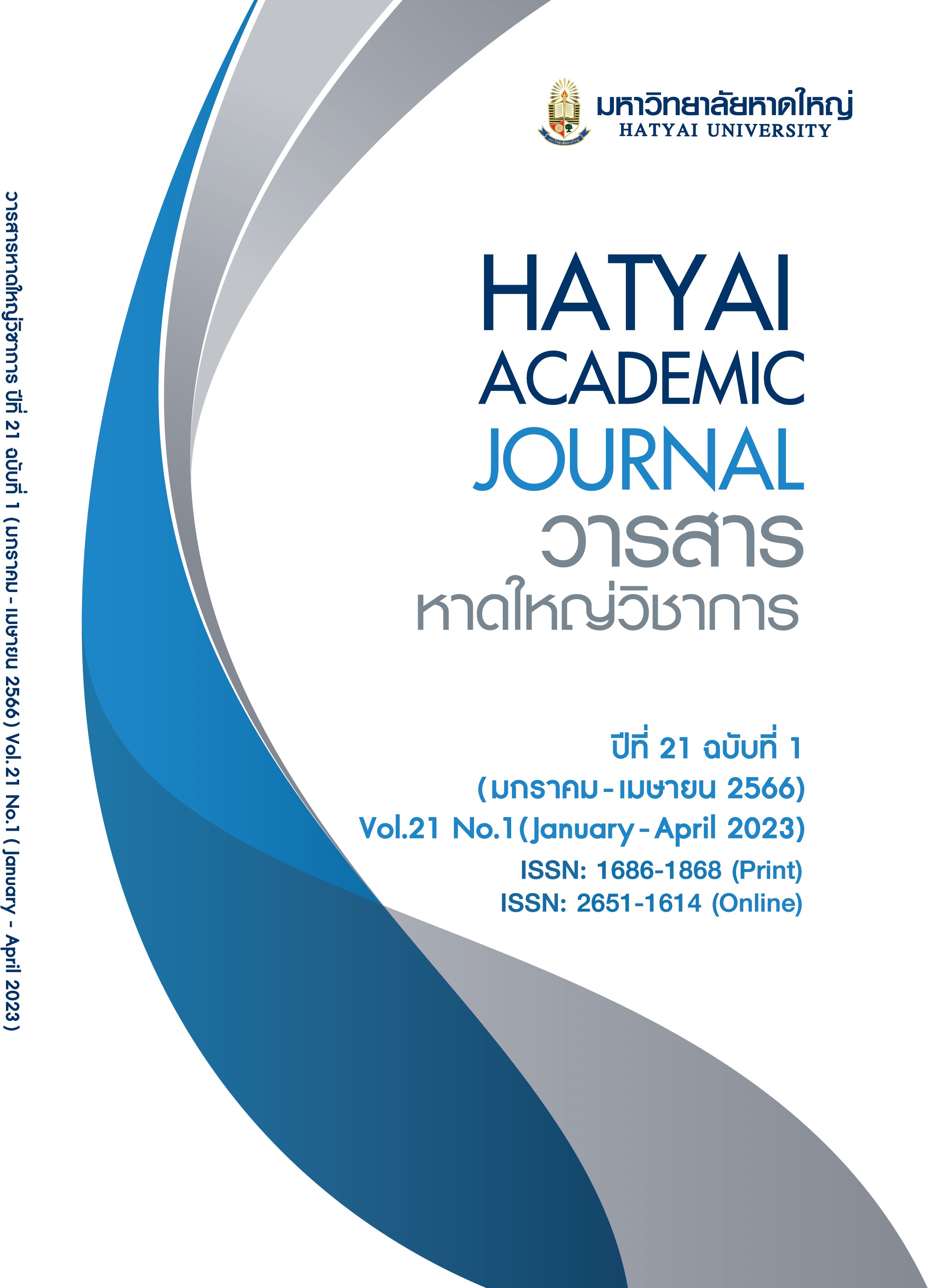The Relationship between Return and Risk of Securities in The Information and Communication Technology Sector in The Stock Exchange of Thailand
Main Article Content
Abstract
Information communication technology has contributed greatly to various connection systems of the country, including the system which deals with investment and economic development. Among many expectations of investors is investment security which brings high returns with low risk. This study aims to analyze the relationship between the return and risk of securities in the information and communication technology sector in the Stock Exchange of Thailand. The study employs the Capital Asset Pricing Model (CAPM) of 15 securities and Generalized Autoregressive Conditional Heteroscedasticity in Mean (GARCH-M) assessing daily stock exchange data from January 4, 2016 to December 30, 2020. The result reveals that the relationship between the rate of return and the systematic risk of 15 securities is in the same direction with statistical significance and is in accordance with the financial theorem under the market efficiency hypothesis. In addition, this approach is also applicable for analyzing the expected rate of return volatility.
Article Details

This work is licensed under a Creative Commons Attribution-NonCommercial-NoDerivatives 4.0 International License.
All published articles are evaluated by three qualified peer reviewers from various institutions through a double-blind process, where reviewers do not know the authors’ identities and authors do not know the reviewers’ identities. The content and articles in the Hatyai Academic Journal reflect the authors’ views only and are neither the opinions of the editorial board nor the responsibility of Hatyai University. The Editorial Board of the Hatyai Academic Journal allows articles to be reproduced for academic purposes, on the condition that the original source is clearly cited.
References
Abbasi, E., Kaviani, M., & Farbod, E. (2017). Testing the traditional CAPM and MCAPM on Tehran stock exchange. Journal of Applied Research on Industrial Engineering, 4(2), 148-157.
Attapoomsuwan, R., & Wanaset, A. (2015). Return and risk analysis of stock in technology industry, stock exchange of Thailand. In The 5 th STOU Graduate Research Conference. Sukhothai Thammathirat Open University, Nonthaburi. [in Thai]
Awirothananon, T., & Auttarat, W. (2015). A comparison between CAPM and the three factor models in analysing stock returns. Journal of Management Sciences, 32(1), 1-17. [in Thai]
Bai, Y., & Green, C. J. (2020). Country and industry factors in tests of capital asset pricing models for partially integrated emerging markets. Economic Modelling, 92(C), 180-194.
Banchuenvijit, W. (2016). A comparison study of the abilities of CAPM and Fama-French in estimating rates of return on energy sector securities listed on the stock exchange of Thailand. University of Thai Chamber of Commerce Journal Humanities & Social Sciences, 36(1), 149-160. [in Thai]
Bendob, A., Chikhi, M., & Bennaceur, F. (2017). Testing the CAPM-GARCH models in the GCC-wide equity sectors. Asian Journal of Economic Modelling, 5(4), 413-430.
Bollerslev, T. (1986). Generalized autoregressive conditional heteroskedasticity. Journal of Econometrics, 31(3), 307-327.
Boonyawat, K., & Wanasilp, W. (2016). Estimation of volatility and return of property development companies in the stock exchange of Thailand. Journal of Economics and Management Strategy, 3(2), 61-69. [in Thai]
Chaiphat, C. (2016). Analysis of expected return and risk of security based on CAPM model: Sharpe ratio and treynor ratio. Suthiparithat, 30(95), 130-142. [in Thai]
Chiang, T. C., & Zhang, Y. (2018). An empirical investigation of risk-return relations in Chinese equity markets: Evidence from aggregate and sectoral data. International Journal of Financial Studies, 6(2), 1-22.
Engle, R. F. (1982). Autoregressive conditional heteroscedasticity with estimates of the variance of United Kingdom inflation. Econometrica, 50(4), 987-1008.
Engle, R. F., Lilien, D. M., & Robin, R. P. (1987). Estimating time varying risk premia in the term structure: The arch-m model. Econometrica, 55(2), 391-407.
Gan, C., Hu, B., Liu, Y., & Li, Z. (2013). An empirical cross-section analysis of stock returns on the Chinese a-share stock market. Investment Management and Financial Innovations, 10(1), 127-136.
Hasan, Md. Z., Kamil, A. A., Mustafa, A., & Baten, Md. A. (2012). Relationship between risk and expected returns: Evidence from the Dhaka stock exchange. Procedia Economics and Finance, 2, 1-8.
Jenwittayaroje, N. (2018). Returns and their persistence from investing in active long term equity funds and active equity retirement funds. NIDA Business Journal, 12(22), 61-86. [in Thai]
Kraipornsak, P. (2016). Econometrics. Bangkok: Chulalongkorn University Press. [in Thai]
Krootboonyong, C. (2014). Principles of investment. Bangkok: Se-education. [in Thai]
Netiniyom, P. (2013). A study of turnaround financial determinants on SET listed companies announced to be turnover list. NIDA Business Journal, 7(13), 61-86. [in Thai]
Noisakul, S., & Khongsawatkiat, K. (2013). Analysis of return and risks of an investment in the stock of service sector by using CAPM. Phranakhon Rajabhat Research Journal Humanities & Social Sciences, 8(2), 20-29. [in Thai]
Rangkakulnuwat, P. (2013). Time series analysis for economics and business. Bangkok: Chulalongkorn University Press. [in Thai]
Ross, S. A., Wethersfield, R. W., Jaffe, J. F., & Jordan, B. D. (2011). Core principles and applications of corporate finance (3rd ed). New York: McGraw-Hill.
Rui, K. X., Rasiah, D., Yen, Y. Y., Ramasamy, S., & Pillay, S. D. (2018). An analysis of the relationship between risk and expected return in Malaysia stock market: Test of the CAPM. International Journal of Engineering & Technology, 7(21), 161-170.
Sangsunt, P., & Sangsunt, Y. (2017). Change of common stocks’ beta in finance industry. Journal of Politics, Administration and Law, 9(3), 645-663. [in Thai]
Sharpe, W. F. (1964). Capital asset prices: A theory of market equilibrium under conditions of risk. The Journal of Finance, 19(3), 425-442.
The Stock Exchange of Thailand. (2021). Market statistics. Retrieved from https://www.set.or.th/th/market/market_statistics.html [in Thai]
Urom, C., Chevallier, J., & Zhu, B. (2020). A dynamic conditional regime-switching GARCH CAPM for energy and financial markets. Energy Economics, 85(C), 1-45.
Wannathanaphong, S., & Chancharat, N. (2016). The comparison between CAPM and APT models for risks and returns analysis of SET50. Panyapiwat Journal, 8(Special Issue), 26-38. [in Thai]
Yakob, N. A., & Delpachitra, S. (2006). On risk-return relationship: An application of GARCH(p,q)–m model to Asia-Pacific region. International Journal of Science and Research, 2(1), 33-40.

